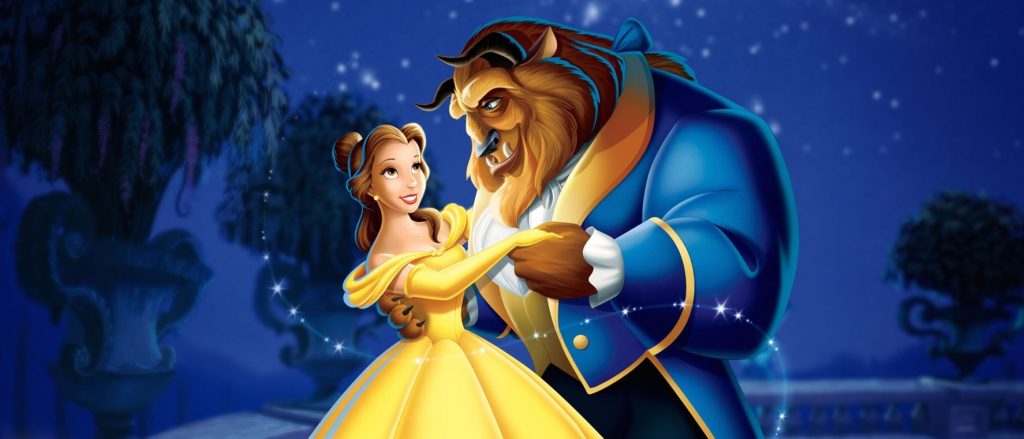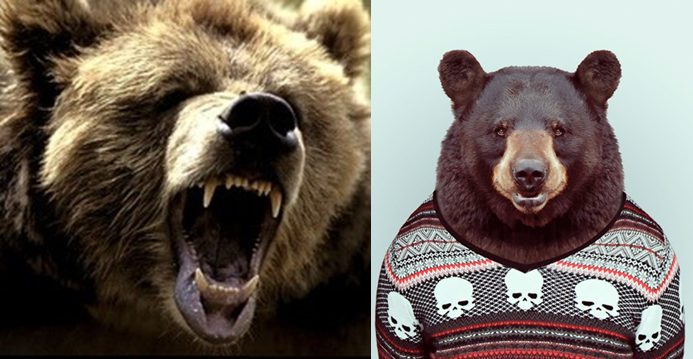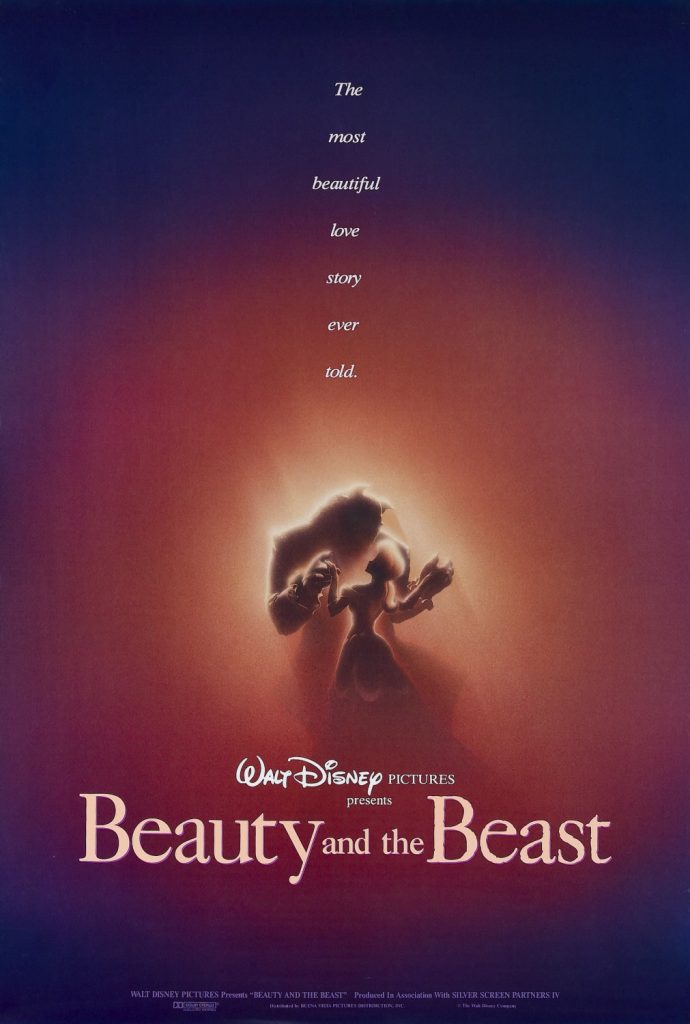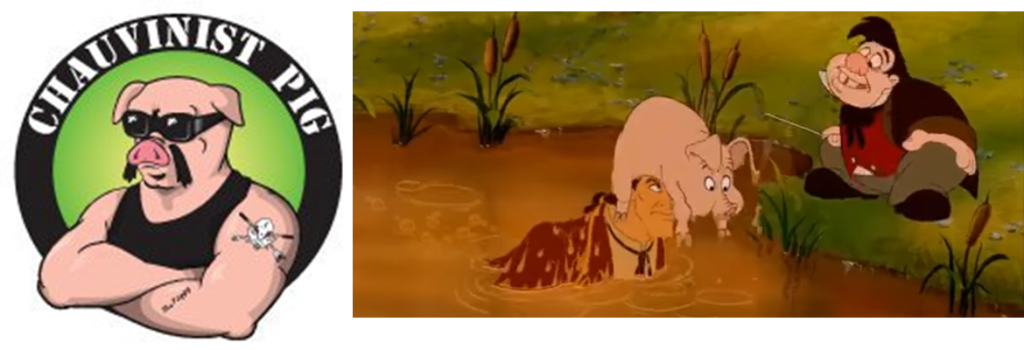Beauty and the Beast, Disney’s early 90s offering follows the protagonist Belle, a clever and beautiful woman. Frustrated at her small town life, she hungers for adventure. She rejects the relentless advances of Gaston, the loathsome but handsome villain and instead falls in love with a ‘hideous beast’; a former prince who has been cursed by his unkind nature. [1] As the Beast learns culture and kindness from Belle, Gaston engineers a plot to imprison Belle’s father so that she is forced to marry him. Ultimately, Gaston is killed by the Beast in the climax of the film and the Beast transforms back to his former human self through an utterance of love from Belle.
As with many Disney films, Beauty and the Beast is inspired by a centuries old fairy tale. Although the origins are unfixed, the film is said to most closely resemble Madame Le Prince de Beaumont’s version. [2] This text features the gradual progression of love between an ‘intelligent and educated’ woman and a ‘cordial, gentle and refined’ Beast (Cummins, p.24, p.26). Through using this story, Disney sought to broaden the horizons of its self-made princess genre, moving away from earlier damsel in distress narratives. Beauty and the Beast, with its emphasis on inner beauty and personal growth,was a new type of film for a new generation of parents ‘who consider[ed] themselves liberated in terms of sexual politics and hope[d] to teach children the same’. [3]
The animalistic figure of the Beast is crucial to this endeavour. Belle must learn to see through his animal form and the Beast’s personal character arc is involved with him moving away from his beastliness in order to regain his humanity.
This means that at the start of the narrative the Beast is introduced as more animal than human. His introduction is more suited to a villain than a romantic lead. As the Beast enters the living room, he disrupts the comfortable domestic space that Maurice is part of. His entrance causes the fire to blow out, launching the room into coldness. Reactionary shots pre-empt his visual arrival, the enchanted furniture cower in fear at the tremendous beast. The film cuts to the Beast as he growls and prowls down the stairs. Dressed only in a cape and shorts, the majority of his bare animal body is revealed and is presented as such to the audience. As Lumière and Cogsworth try to explain the situation the Beast silences them with animal growls rather than language, these growls insinuate a lack of reason and logic. His presence dominates the shots, dwarfing Maurice. He moves like a bear rather than a human, comfortable on all fours before rearing up to intimidate Maurice. Glen Keane, supervising animator for the Beast, called this aspect of his character ‘animal rage’.[4] The film plays into a cultural fear of these animals, especially present in children’s films, such as The Fox and the Hound which includes a bear attack. [5] Therefore, the film feeds into stereotypical perceptions of these animals, who are presented as evil and wilfully unkind.
At the beginning of the film, Belle and the Beast stand on separate sides of a culture/nature dichotomy. The Beast, ostracized in his castle has fully accepted his cursed form. Belle, in the village, is presented to us as a figure of sophistication, due to her avid interest in reading. Wells calls this recognises this as a ‘key contextual grounding of the human/animal discourse’, with ‘the natural world as wild and the recognition of culture as a model of apparently civilised social order’. [6]
Therefore, as the Beast embarks on his journey towards human he must rid himself of his animalistic, wild qualities and learn to be civilised. He is told by his staff and Belle that he ‘must learn to control his temper’. As this rage is coded in relation to the animal, through growls and movement, we understand that in order to earn Belle’s love he must move away from the wildness of nature. Beast begins to dress in full outfits, meaning that the spikes on his back are covered and only his face and paws are on show. Belle’s edification of the Beast is not limited to his mere physical appearance, he is taught how to eat with cutlery and read. These acts are privileged as exclusively human and supposedly convey a bettering of the Beast.
Conversely, Gaston is on an opposite trajectory to the Beast. Gaston begins the film as a comedic character. He is introduced shooting birds from the sky, accompanied by his sycophantic sidekick, LeFou. He is fixated on Belle, calling her ‘the best’ because of her beauty. This introduction reduces Gaston to stereotypical “animal instincts”, unable to care for anything other than animal attraction and merciless killing. Outrageously vain and arrogant, his failed attempts to pursue Belle showcase his stupidity and Belle’s superiority as she effortlessly outwits him.
However, as the film progresses, Gaston’s character darkens. His sexist views are aligned more obviously with animals. When Gaston proposes to Belle he is shot like a ferocious predator. The scene opens with Gaston’s point of view, he is pulling back foliage and spying on Belle’s cottage. This makes Gaston seem like he is stalking his prey: Belle, doe-eyed and graceful. When he enters, Gaston chases Belle around the cottage. As she runs to the door to escape him, Gaston confidently strides across the cottage in pursuit of her. He is seen from below, emphasizing his size. He knocks a chair out of the way, upsetting the domestic environment and his movements are slowed down. He lays both hands around Belle, effectively trapping her and pinning her against the wall. He ignores her rebuttal and goes in to make his attack, puckering his lips for a kiss. In this scene, his sexual violence is coded to be animalistic. Disney makes this connection even more pointedly when Gaston falls into a mud pond and emerges with a pig on his head. A clear reference to the term ‘chauvinist pig’.
When we next see Gaston he is surround by visual cues that relate him to the Beast. He sits on a chair covered in brown fur with horns protruding from the top. He throws beer into the fire which makes it flair up, reminding the audience of the Beast’s introduction. As LeFou tries to placate him he keeps facing away from him, dragging the chair with him as he moves. Through remaining in the chair Gaston becomes one with this motif of the Beast. Moreover, the chair is bare of any human clothes. This communicates that of the two, Gaston is further from human than the Beast.
In both of these characters their beastly qualities are mapped onto an excessive masculinity. Their main physical characteristics are ‘exaggerations of normal male traits: [their] size, [their] hairiness, [their] gruffness, and [their] strength’ (Cummins, p.26). What makes the Beast more likable of the two is that he has had this condition thrust upon him; he is embarrassed by it and seeks to control it. Gaston, on the other hand, demonstrates a pride in this manliness. In the song ‘Gaston’ he boasts about being ‘roughly the size of a barge’ and ‘every last inch of [him being] covered with hair’. The film therefore seems to present these overt shows of masculinity as mostly negative as they represent something wild and uncivilised.
Other animals in the film come down into one of these two boundaries. Belle’s horse, Phillipe is civilised. This is something that is shown through his closeness to Belle and his having a name, which even the Beast is denied. The wolves are wild. Both Belle and her father are terrorised by these yellow eyed, demonic beast and are the only exhibition of complete wildness in the film. When Belle attempts to escape the castle, the pack of wolves tirelessly dog her and Phillipe. The wolves eventually corner Belle and begin to close in on them, growling and even licking their lips in anticipation for the strike. The licking of the lips is multifaceted, it at once pre-empts a carnivorous attack and denotes something sexual, hailing back to the depiction of Gaston earlier. At this point Belle does become a damsel in distress, despite her attempt to fend off the wolves, their wild strength overcomes the civilised nature of her and her horse.
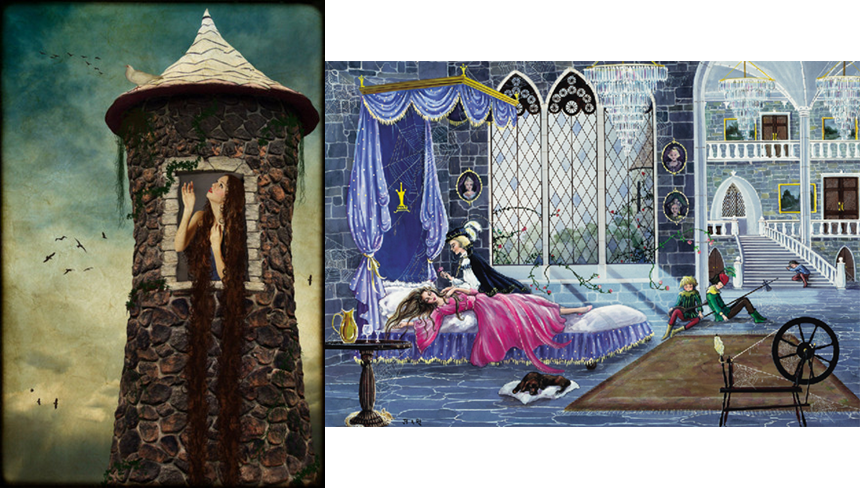
Despite its apparent efforts, Disney can’t quite escape the Damsel in Distress narratives.
Belle is of course rescued by the Beast. This is the first point in the film where the Beast’s condition is consciously rewarded and it problematizes the message of the film. Were the Beast just a man, there would be no way he could have fended off this attack. The Beast is fully bestial at this point. He launches himself over Belle in order to protect her and his cape, a symbol of his human quality, hinders him as the wolves pull him down by it. Fast editing and a dramatic score portray the peril in this scene and the Beast’s and the wolves’ growls silence Belle’s feminine shrieks. Therefore, beastliness is privileged at this point of the film. As he spins around to fight off the attack his mouth and paws become the focus of the shot, demonstrating his immense strength. Although the preceding logic of the film equates the notion of beastliness with connotations of unreason, villainy and sexual predation, it now becomes necessary. This point also marks the turning point in Belle and the Beast’s relationship, their love blossoms after this. Despite the self-conscious distance that Disney has sought to make between earlier narratives, Belle and the Beast’s union is reliant on this moment of heroism and sacrifice.
At the end of the film also, the Beast relies on his supreme strength in order to kill Gaston. The Beast, who has given up on life after the departure of Belle is taunted by Gaston. He acts as a wounded animal, making sounds like a crying dog rather than talking like a human or roaring. Belle’s departure has both dehumanized and emasculated him. This is in contrast to Gaston who is at his most “animal” at this point. His hair is loose, eyes wild and mouth wide; baring his teeth in a bestial fashion. The Beast is only stirred by Belle’s voice. After he hears her cry out, he jumps to defend himself and fights Gaston. Belle’s return is what enables the Beast to commit this act and so only the presence of her femininity allows him to be masculine and beastly.
Ultimately Beauty and the Beast seems confused in its portrayal of bestiality. Although it attempts to frame itself as a progressive narrative it cannot fully commit to this. It at once shuns the Beast and Gaston’s aggressive masculinity through a comparison to animals, and makes Belle dependent on it and rewards the Beast for it, in his union with Belle. Additionally, although Belle is supposed to have been able to look past the Beast’s form and fallen in love with him, the kiss – a notably crucial part of cementing romantic narratives, only happens post-transformation. This may be in order to escape what Wells calls the ‘perverse notion of an intelligent young woman wanting to go out with a buffalo’ but also seems to compromise the meaning of the film (Wells, p.4).
This idea, along with many fairy tale conventions, is parodied in DreamWorks 2001 film, Shrek. [7] A similar plot is followed, with less forceful entrapment and displays of anger, when Fiona, a princess and Shrek, an ogre, bond through a quest narrative. However, this film turns the end of Beauty and the Beast on its head: true love’s kiss transforms Fiona into an ogre rather than back into her human self. This film, in opposition to Beauty and the Beast delights in the idea of being nonhuman, rather than tries to escape it.

A hug rather than a kiss seals Belle and Beast’s love, expressing an underlying discomfort in their interspecies love.
[1] Beauty and the Beast. Dir. Gary Trousdale & Kirk Wise. Buena Vista Distribution, 1991.
[2] Jane Cummins, ‘Romancing the Plot: The Real Beast of Disney’s Beauty and the Beast’, Children’s Literature Association Quarterly, 20.1 (1995) <https://doi.org/10.1353/chq.0.0872> [accessed 15th January 2017] 22-28 (p.23).
[3] K.M. Olson, ‘An Epideictic Dimension of Symbolic Violence in Disney’s Beauty and the Beast: Inter-Generational Lessons in Romanticizing and Tolerating Intimate Partner Violence’, Quarterly Journal of Speech 99.4 (2013) <http://dx.doi.org/10.1080/00335630.2013.835491> [accessed 15th January 2017] 448-480 (p.454).
[4] ‘Creating the Characters of Belle and the Beast – 1991’, YouTube, (2008) https://www.youtube.com/watch?v=__j9okmK9a4 [accessed 16th January 2016]
[5] Fox and the Hound. Dir. Ted Berman & others. Buena Vista Distribution, 1981.
[6] Paul Wells, The Animated Bestiary: Animals, Cartoons and Culture (New Brunswick: Rutgers University Press, 2009) p.19.
[7] Shrek. Dir. Andrew Adamson & Vicky Jenson. DreamWorks Pictures, 2001.
Bibliography
Cummins, Jane, ‘Romancing the Plot: The Real Beast of Disney’s Beauty and the Beast’, Children’s Literature Association Quarterly,20.1 (1995) https://doi.org/10.1353/chq.0.0872 [accessed 15th January 2017] 22-28.
Olson, K.M, ‘An Epideictic Dimension of Symbolic Violence in Disney’s Beauty and the Beast: Inter-Generational Lessons in Romanticizing and Tolerating Intimate Partner Violence’, Quarterly Journal of Speech99.4 (2013) http://dx.doi.org/10.1080/00335630.2013.835491 [accessed 15th January 2017] 448-480.
Wells, Paul, The Animated Bestiary: Animals, Cartoons and Culture (New Brunswick: Rutgers University Press, 2009) p.19.
Filmography
Beauty and the Beast. Dir. Gary Trousdale & Kirk Wise. Buena Vista Distribution, 1991.
‘Creating the Characters of Belle and the Beast – 1991’, YouTube, (2008) https://www.youtube.com/watch?v=__j9okmK9a4 [accessed 16th January 2016].
Shrek.Dir. Andrew Adamson & Vicky Jenson. DreamWorks Pictures, 2001.
Fox and the Hound.Dir. Ted Berman & others. Buena Vista Distribution, 1981.
